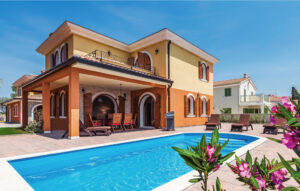Today’s buyers are looking for properties that combine aesthetic appeal, functionality, and security.
When it comes to presenting properties, the difference between real estate agencies often lies in how they approach each segment of the process – from preparation for visual presentation and marketing strategy to personal on-site representation, for Diplomacy&Commerce says Sergio Serdarušić, CEO of Eurovilla. It is crucial for a property to be showcased through high-quality photography and video content.

- What do clients specifically look for when it comes to luxury real estate (square footage, amenities, location, new or old buildings…)?
Clients seeking luxury real estate typically have very high standards and look for a combination of key elements—both in terms of the property itself and its location, as well as additional amenities. Luxury properties generally offer larger floor areas with open layouts that allow for a fluid flow between various zones—living rooms, kitchens, dining areas, and bedrooms. There’s also an emphasis on intelligent use of space, where every part of the property is functional, and details like high ceilings and large windows contribute to a sense of spaciousness.
Clients expect the use of high-end materials (marble, wood, glass) and contemporary design elements that highlight aesthetics and durability. Built-in kitchen appliances, advanced heating and cooling systems, and smart home automation systems (smart home technology) which allow for control of lighting, security, and temperature, are commonly expected. Special attention is paid to details—elegant surfaces, high-end flooring, and personalized interior design solutions.
Location is crucial—luxury properties are usually found in prestigious parts of the city, close to cultural institutions, top schools, fine restaurants, and boutiques. Many clients look for properties with impressive views (of the sea, city skyline, or nature), while also being situated in quieter, secure neighbourhoods that offer privacy and tranquillity. Good transport connections are important, although areas not exposed to daily traffic congestion are preferred, as they enhance the feeling of exclusivity.
Modern projects often attract clients due to contemporary technical solutions, energy efficiency, security systems, and performance guarantees. Design-driven solutions and open-concept interiors are also highly valued. On the other hand, luxury properties with a rich history appeal to buyers who appreciate authenticity, architectural details, and the unique charm of older buildings. Such properties, often located in historical city centres, combine modern comfort with preserved tradition.
Security features like video surveillance, alarm systems, and even private security teams are common in luxury estates. Many projects include private spa centres, fitness rooms, swimming pools, and even green areas or terraces with panoramic views—further enhancing the sense of luxury. Some clients look for additional services such as a concierge, private property management, or regular maintenance options that ease daily living.
Automated systems for lighting, climate control, and security have become standard in high-end properties. Recently, there is a growing focus on energy-efficient design, sustainable materials, and the integration of renewable energy sources, all contributing to a reduced ecological footprint.
Clients in search of luxury real estate expect top-tier quality in every detail. While some focus on impressive square footage and modern features, others value historical charm and exclusive locations. Overall, a luxury property must offer a blend of comfort, aesthetics, safety, and refined amenities tailored to the buyer’s individual lifestyle and needs. This approach allows each client to find the ideal property that suits their taste and requests —whether it’s a state-of-the-art new development or a building steeped in history and character.

- How has the concept of luxury evolved or expanded in today’s Croatian real estate market? What are real estate agents on the ground experiencing first-hand?
The concept of luxury in the Croatian real estate market is undergoing a dynamic redefinition. First-hand experiences from real estate agents reveal a wide range of nuances in how luxury is perceived today. Traditionally, luxury properties were associated with size, prestigious locations (particularly along the Dalmatian and Istrian coasts), and high-end construction and materials. Grand architectural achievements, villas with a view of the sea, or panoramic sights in UNESCO-protected areas were often the hallmark. Today, however, the definition of luxury extends beyond just physical attributes. Luxury no longer necessarily means vast square footage—it now encompasses advanced technology and a high quality of life. Increasingly more international buyers are seeking an “authentic” experience, while maintaining the luxury standards they’re accustomed to in Western Europe. This shift is expanding traditional boundaries of luxury to accommodate specific needs of international buyers. Modern buyers often see luxury in comfort, access to nature, cultural richness, and the quality of services. For many, luxury is now defined as an investment that delivers “experience of a lifetime” rather than just a status symbol. According to many agents, today’s buyers are looking for properties that combine aesthetic appeal, functionality, and security. Therefore, luxury is increasingly measured by the complete lifestyle a property enables, not just by its size or exclusive location. Agents report that premium equipment, smart home systems, and the development of private communities with amenities—like pools, fitness and spa centers—are becoming key selling points. This means that the concept of luxury has expanded to reflect the full experiential value of a property.

- What makes the “difference” between real estate agencies and what should be especially considered when presenting properties (from preparation for visual presentation to on-site showings)?
When it comes to presenting properties, the difference between real estate agencies often lies in how they approach each segment of the process – from preparation for visual presentation and marketing strategy to personal on-site representation. It is crucial for a property to be showcased through high-quality photography and video content. Agencies that invest in professional equipment and filming techniques such as drones or 3D virtual tours create the impression that the property is worth attention. Photos and videos can convey the atmosphere of the space, highlight its advantages, and make the most of natural lighting. Preparing the space through home staging – i.e. furnishing and decorating the interior to create an appealing ambiance – makes a significant difference. Well-arranged, neutral, and modern interiors allow potential buyers to imagine themselves living in the space, while a cluttered or overly personalized environment can diminish its appeal. In addition to traditional photographs, agencies that prioritize digital presentation use social media, virtual tours, interactive cadastral maps, and similar tools to reach a wider audience. Detailed property profiles on the agency’s website, with clear descriptions, technical specifications, and surrounding area details, increase transparency and build trust with potential clients. An agency with well-trained agents is able to convey enthusiasm and respond in detail to all questions potential buyers may have. A skilled agent will highlight all key features of the property – both in terms of visual appeal and functionality – while also tailoring the conversation to the client’s needs. Viewing appointments are often carefully planned to create a pleasant and seamless experience, ensuring that the space is clean and tidy and that the safety of both the host and visitors is guaranteed. An on-site presentation should not be merely formal; it is an opportunity to establish a personal connection with the buyer. Honesty, transparency, and professionalism on the part of the agent are essential, as they increase the potential buyer’s trust in both the agency and the property. It is especially important to provide all relevant information—from technical specifications to financing options—which helps facilitate the decision-making process. Agencies that stand out often offer additional support and advisory services, such as assistance with obtaining necessary documentation, organizing technical inspections, and providing advice on potential improvements after the purchase. This holistic approach can significantly simplify the buying process and enhance overall client satisfaction. The difference between real estate agencies is most evident in the details—how they present properties using visual and digital tools, how they establish communication bridges with clients, and how they personalize and structure their services. Agencies that invest in high-quality photography, home staging, professional viewing preparation, and value-added services gain an advantage in creating a more favourable impression and increasing the perceived value of the property in the eyes of potential buyers. This kind of approach can not only accelerate the sale but also build the agency’s reputation as a reliable and modern partner, which is crucial in a competitive real estate market.